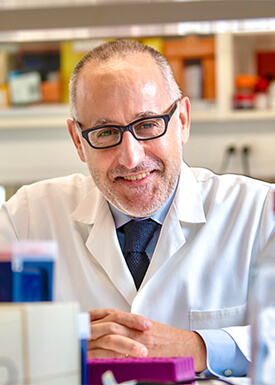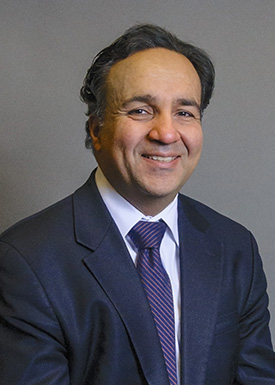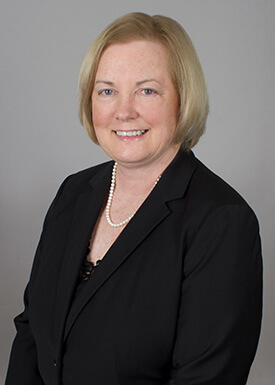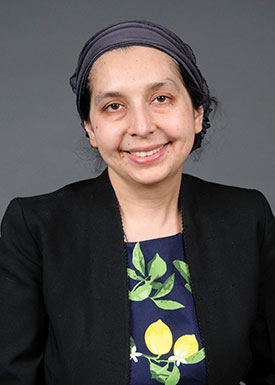 Pablo Argueso, PhD
Pablo Argueso, PhDDirector of Research

Pedram Hamrah, MD
Vice Chair of Research and Academic Programs
Our Investigators

Dr. Pablo Argüeso is the Director of Research. He specializes in corneal diseases and has achieved international recognition for his work studying ocular surface biology. His research focuses on the structure and function of the glycocalyx—a carbohydrate-rich layer lining the surface of eukaryotic cells. His laboratory has developed innovative methods clearly demonstrating the importance of mucins in forming a protective biofilm on epithelial and endothelial cell surfaces. His studies have also uncovered important roles for galectins in the maintenance of ocular surface integrity and immune cell homeostasis, yielding crucial insight into defense mechanisms averting environmental insult and infection. More recent research from his laboratory seeks to define the role of the glycome on pathological remodeling processes associated with wound repair and limbal stem cell deficiency. He has extensively published in high-tier peer-reviewed journals including the Journal of Biological Chemistry, Nature Communications and Science Signaling and has a strong, consistent record of NIH funding of his research.

M. Elizabeth Fini, Ph.D., is Professor of Ophthalmology, and a member of the Pharmacology & Drug Development Program, Tufts University Sackler School of Graduate Biomedical Sciences. She also serves in the newly-created role of Director of the Scientific Staff Career Development Program for Tufts MC. Dr. Fini was recruited from the University of Southern California (USC) in May 2018. She is a molecular biologist with an interest in the body’s protective responses to stress. For many years, her research program focused on the role and regulation of matrix metalloproteinases (MMPs), particularly in the areas of ocular surface/cornea and ocular hypertension/glaucoma. She is an inventor on a Tufts MC patent (#6503892) claiming the use of MMP inhibitors to treat leaking glaucoma filtering blebs and to delay or prevent optic nerve damage in glaucoma. Dr. Fini’s current focus is on molecules that emerged from broad-based screens, and that show promise to be new drugs or drug targets. Clusterin is a molecular chaperone found in the tears that turned up in a biochemical yeast two-hybrid screen for proteins that interact with MMP9. GPR158 is a novel G protein-coupled receptor that was identified in a patient-oriented genomic screen for predisposition to steroid-induced ocular hypertension. Dr. Fini has been developing a patent portfolio around these two molecules with USC, which includes one issued patent (#9241974) and several patent applications in progress. Dr. Fini’s company, Proteris Biotech, is licensing the ocular surface portfolio. The company is developing clusterin for the treatment of ocular surface disease in dry eye. Dr. Fini’s current research is supported by two NEI R01 awards and an SBIR award.

Pedram Hamrah, M.D., is the Vice Chair of Research and Academic Programs, Director of the Center for Translational Ocular Immunology, as well as Professor of Ophthalmology and Adjunct Associate Professor of Bioengineering. He is a cornea specialist and immunologist with specific expertise in corneal immunology and neuro-immune crosstalk as it pertains to ocular surface diseases, neuropathic corneal pain, as well as infectious keratitis. His group focuses on characterizing the functional role of corneal plasmacytoid dendritic cells (pDCs) and conventional dendritic cells (cDCs), a resident leukocyte population he discovered in the cornea. He was the first to discover resident corneal antigen presenting cells in the central cornea, study their function and role in pre-clinical models, study their trafficking mechanisms to the cornea, and translate these findings into clinic through in vivo confocal microscopy studies. The original discovery on cDCs was published in the Journal of Experimental Medicine. His more recent work on pDCs has demonstrated the role of pDCs in corneal nerve maintenance and regeneration through secretion of nerve growth factor and their role in maintaining corneal avascularity through numerous angiostatic molecules. This work has resulted in 3 recent patent applications. Dr. Hamrah is also at the forefront of immuno- and neuro-imaging and has been issued two recent patents on the use of in vivo confocal microscopy to assess inflammation for both diagnosis and assessment of treatment efficacy. His recent work in the clinic has allowed him to identify new treatment modalities for a new disease entity, neuropathic corneal pain, that has been notoriously hard to treat. This work has resulted in a seminal paper on the diagnosis and management of this new disease in Ophthalmology and a joint patent application with the Harvard Medical School to identify these patients through artificial intelligence algorithms. Current studies in Dr. Hamrah’s group are focused on: (i) characterization of the mechanisms behind neuro-immune crosstalk, (ii) developing cell-based therapies with pDCs for corneal, retinal and choroidal neovascularization, and (iii) studying the mechanisms that result in neuropathic corneal pain and development of treatments for this disease. Dr. Hamrah’s current research is supported by three NEI R01 awards and industry agreements.
Arsia Jamali, M.D., M.P.H., Clinical Instructor of Ophthalmology is interested in ocular immunology. His research is mainly focused on functions of a recently identified subpopulation of immune cells, called plasmacytoid dendritic cells (pDCs) in the ocular tissues. Under the supervision of Dr. Pedram Hamrah, Dr. Jamali is investigating the significance of pDCs in maintaining corneal angiogenic privilege and limiting retinal neovascularization in murine models of macular degeneration and retinopathy of prematurity. Further, he is studying the molecular mechanisms and signaling pathways through which anti-angiogenic properties of pDCs can be augmented and is also evaluating the feasibility, efficacy, and potential side effects of adoptive transfer of these cells as a cell-based treatment approach to tackle neovascular ocular diseases.
Abdulraouf Ramadan, Ph.D., Research Assistant Professor of Ophthalmology, is interested in ocular immunology. His research focus is on studying the role of carbohydrate-binding proteins, galectins, on the innate and adaptive immune response against corneal injury and infection. In collaboration with Dr. Noorjahan Panjwani, Dr. Ramadan is investigating the role of galectin inhibitors post corneal injury to prevent retinal gliosis. Further, he is studying the cellular and molecular mechanisms and signaling pathways through which these galectin inhibitors impact the innate immune response. Our overall goal is to develop novel, more effective , therapeutic strategies for the treatment of patients suffering from vision-threatening corneal infections or injury.

Nadia Waheed, M.D., Professor of Ophthalmology and Director of the Boston Imaging Reading Center (BIRC) at the NEEC, is a retina specialist with research interests in imaging of the posterior eye and retinal vascular disease. She led research on the clinical applications of OCT angiography (OCTA), and her work has significantly contributed to the commercialization of OCTA. Her group was the first to describe changes in the choriocapillaris in patients with geographic atrophy related to non-exudative AMD, and in the eyes of patients with intermediate and early AMD. These changes which may serve as a biomarker for disease progression were initially imaged and described on a prototype device developed in collaboration with MIT, and were subsequently replicated by Dr. Waheed’s group on commercial machines. These studies were published in a range of highly respected ophthalmic journals including JAMA Ophthalmology and Retina. Dr. Waheed’s group has also described the pathologic changes in the eyes of patients with early diabetic retinopathy and is characterizing these changes on novel imaging modalities, as a means of developing artificial intelligence powered diagnosis, staging and prognostication for diabetic retinopathy. Dr Waheed’s studies have also resulted in establishing and validating clinical trial endpoints for retinal disease as part of her work at the BIRC. These parameters have been applied to over 15 Phase 2 and Phase 3 clinical trials in the development of new therapeutic agents.
Multicenter Clinical Trials
New England Eye Center faculty have actively participated in, and have developed, numerous clinical trials. Currently, NEEC physicians are actively involved in over twenty clinical trials, across all specialties. These include a Phase IV trial for the treatment of Herpes Zoster Ophthalmicus (NIH), Phase III randomized controlled trial (RCT) involving a surgical implant for neovascular AMD (Genentech/Roche), a Phase III injection RCT for geographic atrophy (GA) secondary to AMD (Apellis), a Phase III RTC comparing faricimab and aflibercept injections for the treatment of diabetic macular edema (Genentech/Roche), a Phase IIIa study of borlucizumab RCT for neovascular AMD (Novartis), a Phase II imaging trial for dry eye disease using varenicline (Oyster Point), and several observational imaging trials studying wet and dry AMD and GA secondary to AMD (BIRC and Boehringer Ingelheim) using multiple modalities including: OCT, OCTA, fundus autofluorescence, and color fundus photography. NEEC recently closed enrollment for Post-Approval Study for the Argus II® Retinal Prothesis System (Second Sight), and is recruiting for the Humanitarian Use Device (HUD) phase. NEEC is also recruiting neuropathic corneal pain (NCP) patients for a study evaluating the use of an intranasal tear neurostimulator (TrueTear®) in improvement of pain symptoms, for an RCT for patients requiring surgical intervention for their uncontrolled glaucoma (Hermann Eye Fund), and Parkinson’s disease patients to investigate whether changes in eye structure can be used to differentiate between neurological conditions and to determine disease progression (Michael J. Fox Foundation). NEEC is also conducting studies involving chronic and acute Herpes simplex virus (HSV)-1 keratitis and uncontrolled glaucoma (Novartis). In addition, NEEC is enrolling specialized populations such as pediatric patients with amblyopia (Deborah Munroe Noonan Memorial Research Fund), EB (The Children’s Glaucoma Foundation), and intermittent exotropia (NIH); and patients with uveal melanoma (NIH). The large patient population that is seen at NEEC provides an excellent source for treating patients with novel treatment modalities.
Environment and available facilities for vision research:
Overall environment for vision research at the institution level is excellent. Currently, there are a total of ten NEI-funded R01 awards, three DOD (vision research program of CDMRP)-funded awards, and 8 (NIH: 7; DOD: 1) pending awards among various Tufts campuses including the TUSM, Tufts MC, Tufts Dental School and the Tufts HNRCA. The Department of Ophthalmology has taken deliberate steps to provide an organized research infrastructure for the multidisciplinary consortium of scientists who conduct vision research in the clinical and basic science departments at the Tufts University Health Sciences Campus. All visions science PIs, regardless of their department affiliation, have access to the equipment in the Department of Ophthalmology. Department of Ophthalmology routinely sponsors activities to: (i) foster collaborative interactions among Tufts vision scientists, (ii) provide leadership in representing vision science within the institution, and (iii) advocate the interests of eye researchers. These activities include:
Monthly Research in Progress Lectures: Vision scientists from Ophthalmology and other departments of various Tufts campuses have the opportunity to present their findings in this informal series. Collaborators from other institutions (e.g. Schepens Eye Research Institute and Department of Medicine, Harvard Medical School) also participate in this lecture series.
Annual Tufts Vision Science Retreat: Vision PIs from various Tufts campuses present their findings at the retreat in the platform session. The ample time is scheduled during each retreat for informal interactions among basic scientists and clinicians. In addition, there is a vision PI faculty meeting to discuss potential collaborative opportunities to compete for NEI multidisciplinary, training and Center grants. Graduate students and postdoctoral fellows are active participants in the retreat. They participate in a poster presentation and competition with two judges, a clinician scientist from Ophthalmology and a scientist from a basic science department.
Frontiers in Vision Science Lecture Series: This is a high-impact lecture series. The speakers in the past include Drs. Eric Pearlman, Lois Smith, Eric Pierce, James T. Handa, Rachel Caspi, Scott Cousins, Bärbel Rohrer, Patricia D’Amore, Stephen Pflugfelder, Joel Schuman, Martin Friedlander and Mark Rosenblatt. Drs. Luk Vanderbrghe, Dan Stamer and Elizabeth Berger are among the speakers scheduled to speak in the 2019 series. These lectures are attended by vision scientists of Tufts and various other institutions in the Boston area.
The above activities have been very successful in fostering new collaborations among vision scientists at various Tufts campuses.
